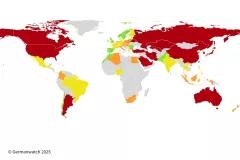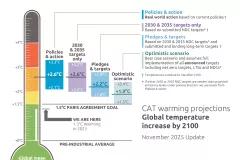
On July 7-8 the leaders of the world’s 20 largest economies will meet in Hamburg for a much awaited G20 summit. The German presidency has made climate change a key agenda item, but cracks in a G20 consensus have emerged after President Trump announced on 1 June that the US would withdraw from the climate treaty.
The ripple effect some feared following the US exit has so far failed to materialise. It remains unclear whether the other 19 members of the G20 – which include major emitters and fossil fuel exporters – can maintain common ground and continued commitment to the goals of the Paris Agreement. As such, the Hamburg summit is a first test for the unity of the coalition. If successful, it can act as a blueprint for climate governance in the age of Trump.
Consequences of US exit on global emissions unclear: It is unclear to what extent the US exit will jeopardize the wider goals of the Paris Agreement. Our recent analysis by the Climate Action Tracker suggests the Trump administration’s policies could lead to US emissions flattening instead of continuing on a downward trend, resulting in 0.4 GtCO2 of additional emissions in 2030. This loss is however overcompensated by positive developments in China and India (notably thanks to reduced coal consumption), which would lead to roughly 2–3 GtCO2 additional reduction in 2030 compared to last year’s estimate.
Investments are key: The dramatic cost decreases in clean technologies over the past few years have made renewables nearly cost competitive with conventional technologies in many major markets. Still, significant additional investments will be needed to complete the transition to a low-carbon economy. Our analysis in the 2017 Allianz Climate and Energy Monitor shows the G20 countries need to roughly double their annual investments to make their power infrastructure compatible with the goals set out in the Paris Agreement, with absolute investment needs estimated at over USD 700 billion per year until 2035.
All countries need to move in the same direction, but start from a very different base: Governments need to move in the same direction, but differences between pathways will be significant, as countries start from very different bases (e.g. the group’s largest per capita emitter, Canada, emits 23 tonnes of GHG emissions per capita on a yearly basis or 9 times as much as India, the group’s lowest per capita emitter). We compiled these different country-specific circumstances in emissions development, trends towards decarbonisation, financing conditions and policy in the Climate Transparency factsheets.
G20’s climate performance is improving but still insufficient: This year’s Brown to Green Report from Climate Transparency concluded that the G20 countries use energy more efficiently and use cleaner energy sources, but energy consumption has grown alongside economic growth. The overall growth of greenhouse gas emissions is slowing, energy related emissions are even stagnating, but overall emissions do not yet decline. Renewables are on the rise, but coal and other fossil fuels still dominate the G20’s energy mix. Fossil fuel subsidies and other government support to fossil fuels is still widely spread across the G20.
G20 still have a long way to go: What can now be hoped for is that the G20 - minus the US - make a strong commitment to the Paris Agreement in the leaders’ declaration. High-level leadership can help to increase ambition and make the transition to a low-carbon economy faster. This includes translating the long-term climate change goals to concrete next steps, such as the accelerated phasing out of fossil fuel subsidies and public support for fossil fuels, as well as supporting investments in clean technologies and continuing the renewables revolution.







